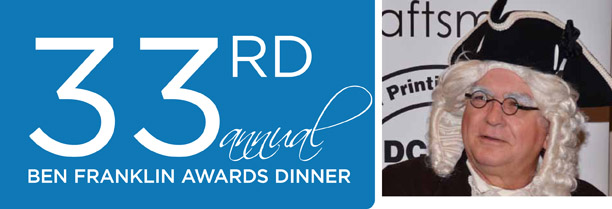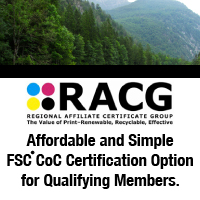
PIM Member Profile: Walsworth Publishing Company
Presence. Performance. Personalization.
By John Gumina

These three words probably best describe Walsworth Publishing Company, this issue’s Printing Industry of Michigan “Member Profile.”
Along with its facility in St. Joseph, Michigan—acquired just five years ago—the Missouri-based Walsworth has continued to expand its operational presence throughout the U.S., and maintains an international reach as well.
Founded in Missouri in 1937 by Don Walsworth, the company is still family owned and specializes in printing yearbooks, catalogs, periodicals and books. It performs among the 30 largest printing companies in the U.S. overall, and is among the top 10 publications printers and top five book printers. Today, it employs some 1,250 people worldwide.
Walsworth is further distinguished by the fact it is the last privately-held printer of yearbooks among the Big Five, and it has more than 675 employees who have attained “Master Printer of America” status!
According to Tom Ashton, Sales Director, Eastern Region at Walsworth Print Group, at its core the company has a philosophy of placing the client first, and maintains a “big enough to help but small enough to care” approach.
It is this personalization, so to speak, which has kept the majority of clients working with Walsworth for fully 10 years or more.
The St. Joseph, Michigan facility offers a full-service print operation, from receipt of files to shipping out the door. “We have heatset web presses as well as sheetfed presses,” Ashton states. “We can stitch or perfect bind projects across the entire platform, or if sewing and case-binding are needed, rely on our Missouri plant. Following completion, we can ship to a destination, mail through our onsite U.S. Postal verification, co-mail, or hold in our warehouses for ongoing fulfillment and distribution.”The manufacturing operation at St. Joseph occupies 150,000 square feet in its own building. Administrative offices are located across the street in 9,000 square feet, and the Fulfillment Operation occupies 50,000 square feet of warehouse and office space in a 500,000 square foot building nearby.
Walsworth acquired IPC of St. Joseph five years ago from Journal Communications, Ashton points out. This was part of a strategic expansion of Walsworth’s platform, its scope of offerings, the markets it served and its product diversification. (IPC had operated in the St. Joseph region for decades prior to the acquisition, occupying a number of facilities.)
About 195 individuals work at the St. Joseph Walsworth facility today which most recently began implementing a new enterprise wide production system to streamline operations and improve efficiency and tracking.
Ashton states, “We have added several new presses and supporting operations, including platesetters and paper handling equipment. We continue to invest significantly in both our local Michigan operation and across our entire platform. Our annual investment easily exceeds $5,000,000 across our platform, as we seek to improve operations and grow our services. In addition to the pressroom equipment, we have invested significantly in our Integrated Solutions suite of services.” Shortly after Walsworth acquired IPC, Ashton joined the company.
“I am responsible for leading our Eastern Region sales team, selling our entire platform. The team is selling solutions applicable to the catalog, periodical and book markets in addition to ongoing fulfillment services and integrated digital solutions.” Ashton emphasizes “the vast majority” of Walsworth clients have been with the company for 10 years or more.
“We count our clients both in numbers and in longevity,” he adds, noting Walsworth prints many hundreds of focused publications, niche and specialty catalogs, and books of all kinds. But services go beyond this.
Ashton states: “We’ve been working with one long-time client, for example, in revising their website and their marketing strategy to incorporate different conversation streams and methodologies, their approach to new subscriber acquisition, as well as, the layout and design of their magazine.”
This has already resulted in more than an 11% increase in new subscriptions and well over a 200% increase in web traffic, he adds.
In an economy that appears to be growing, but still remains challenging, Ashton states Walsworth: “Continues to identify where we can have the greatest impact on the success of our clients and prospects. We focus our efforts on those activities. By refining our approach we can make our marketing and selling more effective, and negate the need to trim or eliminate.”
What about future plans?
Ashton notes Walsworth is continually investing in both traditional brick-and-mortar operations along with the supporting and complimentary services, such as its “Apps” and “Integrated Solutions” programs.
Walsworth Apps helps its clients to develop and deliver compelling content to readers wherever they are and on whatever devices they use – computer, tablet or smartphone. Ashton adds Walsworth Apps offer a rich content-viewing experience, interactive advertising opportunities and real-time analytic insights along with a new component which reviews, recommends and defines new revenue opportunities for the client.
“Integrated Solutions typically begin with a Digital Presence Assessment, so we can help the client stack rank where to invest time and effort to get the best return. For some, it means revamping the website or tweaking SEO, while for others, it means developing apps with responsive design and frequently updated content. One size doesn’t fit all: we tailor our digital efforts to compliment the traditional printed vehicle so each leverages and enhances the other.”
As a member of its local communities, Walsworth is proud to participate in activities and efforts to support the residents, Ashton points out. “We have been a pacesetter company for the United Way campaign in the past and continue to run an employee campaign each year,” he states. Walsworth’s presence in Michigan also goes beyond the local. “We are proud to partner with Susan G. Komen of Michigan for whom we provide in-kind printing services.”
Walsworth also participates in “green” activities. For example, all of the overhead lighting at its St. Joseph manufacturing operation has been replaced with energy efficient fixtures. “We maintain Forest Stewardship Council (FSC) and Sustainable Forestry Initiative (SFI) certifications for sustainable forest paper products,” Ashton says. “We also recycle 100% of our process waste paper. Additionally, our Sunday web press is a zero-emission press, meaning atmospheric exhaust from that press is water vapor only.”
An active Printing Industries of Michigan member, Walsworth views its membership as “an effective way for us to connect with our colleagues in the industry,” Ashton states. “It helps our organization locate potential production partners, both for specialty applications and overflow resources but also for presenting Walsworth capabilities to other members.”
PIM also serves Walsworth as a method of information consolidation and distribution, both internally and across its local industry, Ashton adds.
For more information about Walsworth, visit its website at walsworth.com, or call Tom Ashton at 269.428.1200. You can also email them either through the website, or through thomas. ashton@walsworth.com







 Streaming media has been transforming the music industry along side of TV and movies. While digital downloads still represent the largest percentage of music sales in the US, they are falling. Meanwhile, streaming music services like Pandora, Spotify and Apple Music have already overtaken physical CD sales and represent about one third of the industry’s income. Some analysts expect revenue from music streaming to surpass that of digital downloads in the near future.
Streaming media has been transforming the music industry along side of TV and movies. While digital downloads still represent the largest percentage of music sales in the US, they are falling. Meanwhile, streaming music services like Pandora, Spotify and Apple Music have already overtaken physical CD sales and represent about one third of the industry’s income. Some analysts expect revenue from music streaming to surpass that of digital downloads in the near future.

 At age 16, Adrian obtained a four-year apprenticeship as a metal type compositor with the printer Otto Schlaeffli in Interlaken. He also took classes in drawing and woodcuts at a business school in the vicinity of Bern. In 1949, Frutiger transferred to the School of Applied Arts in Zürich, where he concentrated on calligraphy. In 1951, he created a brochure for his dissertation entitled, “The Development of the Latin Alphabet” that was illustrated with his own woodcuts.
At age 16, Adrian obtained a four-year apprenticeship as a metal type compositor with the printer Otto Schlaeffli in Interlaken. He also took classes in drawing and woodcuts at a business school in the vicinity of Bern. In 1949, Frutiger transferred to the School of Applied Arts in Zürich, where he concentrated on calligraphy. In 1951, he created a brochure for his dissertation entitled, “The Development of the Latin Alphabet” that was illustrated with his own woodcuts. Along with the modern art and design movements of the early twentieth century, a reconsideration of the largely experimental work of the first generation of sans serif types began in the 1920s. Fonts such as Futura, Kabel and Gill Sans incorporated some of the theoretical concepts of the Bauhaus and DeStijl movements and pushed sans serif to new spheres of respectability.
Along with the modern art and design movements of the early twentieth century, a reconsideration of the largely experimental work of the first generation of sans serif types began in the 1920s. Fonts such as Futura, Kabel and Gill Sans incorporated some of the theoretical concepts of the Bauhaus and DeStijl movements and pushed sans serif to new spheres of respectability. In the 1930s, especially within the European countries that fell to dictatorship prior to and during World War II, there was a backlash against modernist conceptions. Sans serif type came under attack, was derided as “degenerate” and banned in some instances. Exceptions to this trend were in the US, where the use of grotesque types was increasing, and Switzerland, where the minimalist typographic ideas of the Bauhaus were brought by designers who had fled the countries ruled by the Nazis.
In the 1930s, especially within the European countries that fell to dictatorship prior to and during World War II, there was a backlash against modernist conceptions. Sans serif type came under attack, was derided as “degenerate” and banned in some instances. Exceptions to this trend were in the US, where the use of grotesque types was increasing, and Switzerland, where the minimalist typographic ideas of the Bauhaus were brought by designers who had fled the countries ruled by the Nazis. After the war, interest in sans serif type design was renewed as a symbol of modernism and a break from the first four decades of the century. By the late 1950s, the most successful period of san serif type opened up and the epicenter of this change emerged in Switzerland, signified by the creation of Helvetica (1957) by Eduard Hoffmann and Max Miedinger of the Haas Type Foundry in Münchenstein.
After the war, interest in sans serif type design was renewed as a symbol of modernism and a break from the first four decades of the century. By the late 1950s, the most successful period of san serif type opened up and the epicenter of this change emerged in Switzerland, signified by the creation of Helvetica (1957) by Eduard Hoffmann and Max Miedinger of the Haas Type Foundry in Münchenstein. This was the cultural environment that influenced Adrian Frutiger as he set about his work on a new typeface as a Swiss trained type designer at a French foundry. As Frutiger explained in a 1999 interview with Eye Magazine, “When I came to Deberny & Peignot in Paris, Futura (though it was called Europe there) was the most important font in lead typesetting. Then one day the question was raised of a grotesque for the Lumitype-Photon [the first phototypesetting system]. …
This was the cultural environment that influenced Adrian Frutiger as he set about his work on a new typeface as a Swiss trained type designer at a French foundry. As Frutiger explained in a 1999 interview with Eye Magazine, “When I came to Deberny & Peignot in Paris, Futura (though it was called Europe there) was the most important font in lead typesetting. Then one day the question was raised of a grotesque for the Lumitype-Photon [the first phototypesetting system]. … Originally calling his type design “Monde” (French for “world”), Frutiger’s innovation was that he designed 21 variations of Univers from the beginning; for the first time in the history of typography a complete set of typefaces were planned precisely as a coherent system. He also gave the styles and weights a numbering scheme beginning with Univers 55. The different weights (extended, condensed, ultra condensed, etc.) were numbered in increments of ten, i.e. 45, 65, 75, 85 and styles with the same line thickness were numbered in single digit increments (italics were the even numbers), i.e. 53, 56, 57, 58, 59, etc.
Originally calling his type design “Monde” (French for “world”), Frutiger’s innovation was that he designed 21 variations of Univers from the beginning; for the first time in the history of typography a complete set of typefaces were planned precisely as a coherent system. He also gave the styles and weights a numbering scheme beginning with Univers 55. The different weights (extended, condensed, ultra condensed, etc.) were numbered in increments of ten, i.e. 45, 65, 75, 85 and styles with the same line thickness were numbered in single digit increments (italics were the even numbers), i.e. 53, 56, 57, 58, 59, etc.




